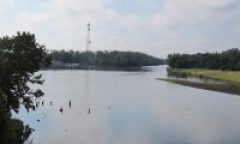The following are stories that were traditionally told on Caltech steam tunnel tours, circa 2005-2009. Roman text is a rough approximation of the stories that were told; text in italics are my additional commentary and explanations.
These stories are reproduced for the historical record, as it is my understanding that the tradition of steam tunnel tours at Caltech died out a number of years ago. The locks that used to open with South Master have been changed, and the penalties for entering the steam tunnels are much more severe than they once were.
More details can be found here.
Tales from the Biology Basements
At one point, the tour passes from a tunnel into the basement of a biology lab. We file down a hallway until we come to a cluster of vending machines.
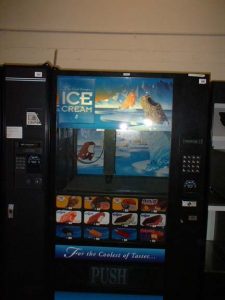
This is the largest cluster of vending machines on campus, and can be a convenient place to come for food if you’re up all night working on sets and the C-Store is closed. It’s also, apparently, where postdocs eat all their meals when their advisors won’t let them out of lab until they publish another paper.
The real reason we’ve stopped here, though, is to get ice cream from the only ice cream machine on campus. Once you select what you want, watch through this window and you can see a robot arm with a suction hose on the end pick up your selection and carry it over to the dispenser. On the rare occasions when it drops one, it turns out that it notices and picks it up again.
After everyone is done getting ice cream, we continue on through a double door down a long, narrow, and deeply slanted corridor that runs under the San Pasquel walk, taking us from the basement of Church to the basement of Braun, another bio lab.
This passage way is certainly not known as “Skateboard Alley”. Because, of course, no one would be stupid enough to ride a skateboard down it. And certainly not a “Safety Cart” they’d made by welding two shopping carts together, top-to-top. Of course not. That’s why you’ll notice that that section of wall near the bottom hasn’t been specially reinforced with padding. Or, rather, as it clearly has, this must just be because of biologists losing control of their lab carts or something.
Another story is told in the basement of Braun Labs, at the bottom end of Skateboard Alley.
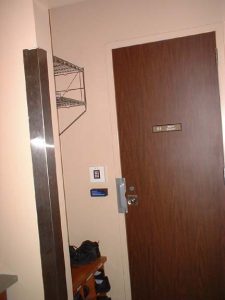
If you’ll look to your right, you’ll see what must be the world’s highest security women’s shower, followed by what must be the world’s highest security men’s shower. As well as unpickable Medeco locks, they also have ID card swipes and combination locks on the doors. And the door right after them has a large peephole in it looking out, with a note on the door about it being a “Feed Room”.
You’ll also perhaps notice that the “Feed Room” and the showers have the standard lab hazards signs next to them, with a list of emergency contacts. It turns out that none of the people listed on them, however, are listed anywhere else in the Caltech directory, and all their phone numbers are given as the emergency phone number for Security. Furthermore, the shoes on the racks by the doors to the showers are all the same size and never change or move: someone once put a bunch of quarters in one of them, and they were still there six months later.
Besides that, all we know is that one time, when animal rights groups came to campus to protest genetic engineering experiments and threatening to break in and release all the lab rats, the lab across the hall posted a large sign on their door, informing all comers that “We have no idea what they’re doing across the hall, but we have nothing to do with it.” You may draw your own conclusions.
Inside a machine room accessible from the basement of a biology building, we come to a large open area with a wide pit and a ladder leading down into it. As we climb down, it gets noticeably colder and we can feel a strong wind blowing over us. After we all get to the bottom, I shine a flashlight on one wall, where you can see a mural of the word “FEAR” in the style of the Cow, but using dark blue rather than yellow paint for the letters, and with no illuminations or other adornments.
Welcome, to Fear! This is the last of the Cow’s four murals and, unlike the others, it’s unfinished. No one actually knows why he didn’t finish it, but there are several rumors. One is that he needed a special paint that would stick properly despite the wind down here, and it was too expensive. Another is that, seeing as we’re in the building’s ventilation system, people smelled fumes from the drying paint and Facilities tracked the source to here and stopped him. However, some of us prefer to believe that the incompleteness is intentional, and symbolizes the greatest fear: the fear of the unknown.
If you turn around, you’ll see that all this wind is coming through a tunnel that you can see a bit of light at the end of. It used to be traditional to run through the tunnel without lights, but this isn’t really safe because there are a few random bits of re-bar sticking out of the floor. But it is still fun to run through as fast as you safely can.
Beware of Round Tunnels
We find ourselves facing a T-junction, with two options: a tunnel with a round cross-section heading south, or a tunnel with a square cross-section heading north. We choose the square tunnel.
One lesson that it’s important to learn before you go tunneling too much on your own is that you should always avoid round tunnels. They only show up in two places: here, heading south to Physical Plant, and on the other end of the North Tunnels, heading east to the Center for Student Services. In both cases, these are places that Administration really wants to keep students out of, and so both of them have motion sensors that alert Security.
A couple of decades ago, though, when the motion sensors were first installed, a clever student found a way to disable them. He decided he couldn’t risk just taping them over, because Security would notice that they didn’t go off even when someone was supposed to be working in that part of the tunnels. Instead, he got an old industrial-style window fan, modified it to look more official, with Caltech logos and such, and installed a timer so that it would turn on for five minutes out of every thirty. He and some friends then managed to set it up where it would activate the motion sensor whenever it turned on, figuring that Security would get tired of sending someone down to check on things every time the sensor went off, and would soon start ignoring it.
When Security discovered why their fancy new motion sensor was giving so many false positives, though, they decided to ask Facilities about the fan and why it was there. At this point, it’s important to understand that Caltech has always made a big deal of having students involved in administration by serving on committees with faculty and administration. For example, there are undergrads on the admissions committee, and on the committee that makes decisions about the Core curriculum, and so on. Back in the Seventies, when this happened, there were undergrad representatives on the Facilities committee as well. One of them happened to be friends with the person who’d made the fans, so when she saw Security asking about fans as an agenda item for the next meeting, she knew what it must be about.
Anyway, she prepared for the meeting with a doctored version of the Pasadena building code and managed to bluff everyone involved—since the head of Facilities was new and didn’t want to admit he wasn’t an expert on the local building code—into believing that such fans were required every one hundred feet in utility tunnels to disperse possible toxic gases, but that students had stolen most of them over the years to use as window fans during the summer. This seemed plausible enough, given Pasadena’s tendency to have dumb laws and California’s tendency to overreact to the risk of “chemicals,” and the committee ended up deciding to install timed fans throughout the steam tunnels.
These fans persisted in the tunnels for a couple of years until the head of Facilities was replaced by someone more competent, who realized that they were pointless and had them removed and thrown out. This ended the false positives for the motion sensors, but it also meant that students were able to scavenge them from dumpsters and get free, high-quality fans for their dorm rooms, once they pulled out the timer circuits.
The warning against round tunnels had long been part of tunnel lore when I was a frosh. It was due to the fact that there were two places in the main steam tunnels with circular cross-sections: the approach to the main physical plant area, and the approach to the building with the registrar’s office, both of which were guarded with motion sensors.
However, the rest of this story is a new addition, which two friends and I came up with during my sophomore year as an experiment: we started telling it on our tunnel tours, and within a couple of years, it apparently had become included in the lore without the then-current undergrads realizing it was new.
For the Love of God, Montresor
Somewhere in the North Tunnels, there is a four-way junction, with long tunnels extending off into the dark on two opposite sides, a locked door on one side, and hastily-made wall of cinder blocks obstructing the tunnel opposite it. The door has “Caltech Sucks! — HMC” written on it in large letters of black spray paint, and the cinder block wall looks clearly out-of-place and has a small gap near the top that a tall person can look through with a flashlight.
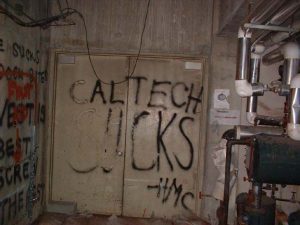
You may have been wondering why we’ve been counting you every so often. One reason is that we don’t want any of you to get lost and then not know how to get out. But another reason is that we don’t want you sneaking away intentionally. A number of years ago, a group of students from Harvey Mudd, an engineering school down the road in Claremont, snuck along on a tunnel tour, pretending to be prefrosh.
At some point, they snuck away from the group and wandered around, looking for something to graffiti. They came to this door, and spray-painted the message now see on it. They then tried to get out of the tunnels before anyone caught them. But they found out that this door was locked and, not being Caltech students, they didn’t have South Masters or lockpicks, so they couldn’t open it.
They ended up spending several hours wandering around until they were found by a search party that had been sent out when their tour came back. It just so happened that when they were found, the closest door was this one into the Noyes subbasement, so the search party took them there. They then found this message in fresh spray paint, and noticed that the Harvey Mudd students had wet paint on their hands. It was fairly clear what they must have done.
Now you should all—especially if any of you are Harvey Mudd or MIT students who’ve snuck along—take a look at what’s in the other dead end here, behind that bricked-up wall. Have you all read “The Cask of Amontillado”? If so, perhaps you can guess what’s there. If you stand on this cinder block here, you can look through the crack with a flashlight and see for yourself.
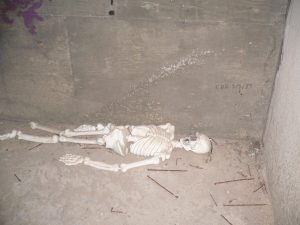
Feynman’s Bed
In a well-lit but noisy machine room, we file through a door in a metal wall into a dark and narrow passageway with several elevated alcoves, each a few meters square, to one side. It’s noticeably cooler in here and we have to be quiet: if you look at the ceilings of the alcoves you realize that they’re sidewalk grates. We stop in front of one with an incredibly dusty-looking king-sized mattress. Above it is a rope swing hanging down from a grate through which we can see star light.
I’m sure you’ve all heard stories about Richard Feynman, who used to be a physics prof here. It’s well known that he picked locks and opened safes while he was working on the Manhattan Project at Los Alamos. He also taught a class on lock-picking to undergrads for a while. But, what’s less well known is that he once spent a night in the steam tunnels, sleeping on this mattress. The story goes that he once made a bet with an undergrad about some physics fact that the undergrad thought he’d gotten wrong. Anyway, the forfeit he agreed to if he was wrong was that he’d have to sleep in the steam tunnels for a night.
And so, when it turned out that he was wrong, he dragged this mattress down here and slept under the stars in the steam tunnels, presumably because it’s rather cooler in here than in most other places: the tunnel leading to the End didn’t exist in those days, as it runs to Broad Lab, which was only built about ten years ago. However, it’s worth noting—though the undergrad apparently didn’t call him on it—that he technically cheated, because machine rooms like this don’t really count as part of the tunnels, so all he really did was to spend the night in an unpleasant part of a biology building.
This story was not always included in steam tunnel tours: some of my friends who were less experienced in leading tours didn’t know it, while others only visited Feynman’s Bed and told the story if they needed to kill time while waiting for another group to exit Shadowlands. However, I was fond of it and made sure to always include it in my tours.
The Shadowlands
Across the tunnel from the machine room where Feynman’s Bed can be found, there is a small, square door in the tunnel wall. We have to bend down to go through it, and once we get through and the door is closed, we find ourselves in complete darkness.
Welcome to Shadowlands! This bit of tunnel is one of the most isolated spots on campus. It appears to have been excavated as access to a new building that was never built: as you can see, there are bits of rebar sticking out of the walls and floor that could be used to mount the frames for steam pipes, but no frames or pipes seem to have been installed.
One consequence of its isolation is that you can make an incredible amount of noise down here without being heard anywhere else. People occasionally come down here to scream to let off stress after finals. And Ditch Day stacks frequently make use of the place. For example, the broken-open concrete boxes you see over there are the remnants of a stack that required the frosh to break open the boxes without touching them: the solution turned out to involve playing a sound at their resonant frequency until they cracked.
The fact that the Shadowlands don’t have any steam pipes or utilities, along with their being a dead-end, also makes them a convenient place in the tunnels to set up stacks that require a lot of time and space for set-up. In my time at Tech, it was used for a laser maze one year, and for a large three-dimensional physical maze one had to climb through another year.
Lloyd-Grade LSD
Walking through the North Tunnels, we take a right and enter a corridor that’s not quite tall enough for most people to stand up straight. To the left, there are rather large alcoves, shaped like the sort of trapezoidal table that can be paired up to form hexagons, only a little larger. Each of these has a bench-sized concrete block running along its base.
One of the alcoves is full of smashed computer monitors: we climb up on the bench of that one and see that this bit of the tunnel is two stories tall, though the pipes that lined the ceiling continue through it, so the upper section can’t be seen except by standing on the bench. Another mural in the Cow’s style—yellow letters spelling “HOPE” on a black background with many embellishments—fills the wall opposite us:
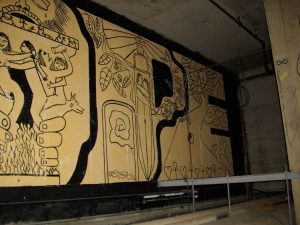
We’ve finally come to the last of The Cow’s murals that we’ll see tonight, Hope. As in Love and Faith, he’s filled it with a number of house symbols including one that’s seem somewhat less often than “DEI”, “FEIF” and “γδβγ”: “LSD.”
Back in the Sixties, the FBI noticed a particularly high grade of LSD becoming common on the West Coast. LSD, you see, is a chiral molecule, and only one of the two enantiomers is biologically active. Previous manufacturers of LSD hadn’t bothered to separate the two enantiomers, but enantiomerically pure LSD, called “Lloyd-grade LSD” was becoming well-known. They managed to trace the source to the Los Angeles area, and then to Pasadena. Having done this, they realized that Caltech had a dormitory called “Lloyd”, as well as having the sort of students who might be able to make enantiomerically pure LSD. One day, several FBI agents arrived at the Caltech President’s office to warn him that there’d be a raid on campus the next day.
The following morning, FBI agents descended on Lloyd House and began searching all the rooms. However, they found nothing. Then they got the official blueprints from the Housing Office to see if it was possible that a room had been hidden in some way, but they failed to find anything amiss. They were about to give up when someone noticed that two of the rooms in Purple Alley seemed somewhat bigger on the blueprints than in reality. They investigated the common wall between these two rooms more carefully and found a concealed doorway: it turned out there was actually a room in between them that had been erased from the blueprints.
The FBI agents entered the room, expecting to find a secret LSD lab, but upon searching it they didn’t find a single spec of LSD. However, there was a large cake and a banner with the message “Lloyd House Welcomes the FBI”. It turned out that a student worker in the President’s office had noticed the FBI agents visiting the previous day and had informed the Lloyd president, who made an announcement at dinner that “I don’t know who you are, and I don’t know what you’ve been doing, but the FBI is coming tomorrow, and I don’t want to see you here ever again.” The seniors who’d been running the lab apparently took this as a warning to clean up their lab and then fled to Mexico. And, in fact, only three seniors in Lloyd are listed as having graduated in that year’s Big T (the Caltech yearbook).
As far as I know, no one’s done a FOIA request to try to get the FBI’s records of the raid, but a student my year in Blacker tells me that his parents claim to have done Lloyd-grade LSD in college at Washington University in St. Louis, and the residents of Purple Alley are apparently willing to show visitors the room that housed the LSD lab.
This story certainly has some similarities to an MIT hacking story, “Bexley versus the FBI,” and it seems likely that one of the stories is a modified version of the other. I certainly think Caltech’s version is a better story…but I also have to admit that my attempts to search the archives of The California Tech (the school newspaper) for evidence of the truth of the story didn’t turn up anything.
Impeach Nixon!
Pranks really shouldn’t be too disruptive to life on campus. In fact, Caltech’s pranking traditions have a rule that you should always leave a note with contact information along with a prank, in case you’re needed to clean it up, and it is often considered best practice to warn the relevant administrators or faculty of what is going to happen.
On occasion, whether by accident or by design, pranks do end up causing a good deal of trouble. One of the more disruptive and famous pranks from the Seventies, the “Impeach Nixon!” banner, caused enough of a political stir to get the House responsible for it disowned by the family that it was named after.
At some point during the Watergate scandal, President Nixon visited Caltech. In preparation for his visit, a group of Darbs scaled Milikan and hung a huge banner reading “Impeach Nixon!” from the side. As required by the Honor Code, they left a note saying that if it caused any problems, Security could call Dabney for help taking it down. In the morning, Security discovered the banner and panicked: they clearly couldn’t leave this up when the President of the United States showed up in few hours. They couldn’t figure out how to detach the banner, though, and decided to call Dabney for help.
However, there was a complication. There are two buildings on campus named “Dabney”: one is Dabney House, the undergrad dorm responsible for the prank, while the other is Dabney Hall, the the older of the two humanities buildings. Anyway, Security somehow got the idea that, since Dabney Hall was closer to Milikan than Dabney House, someone there—an angry radical humanities professor, perhaps?—must have been responsible. They then spent half an hour calling every office phone in Dabney, and then searching the building, but failed to find anyone because it was six in the morning and none of the faculty had gotten in yet.
Security ended up cutting down the banner without removing the attachments the Darbs had used–they’re still attached to the front face of Milikan as a result—but the Dabney family, which was very conservative and had earned its money in the oil industry—officially disowned Dabney House in response to the prank.
